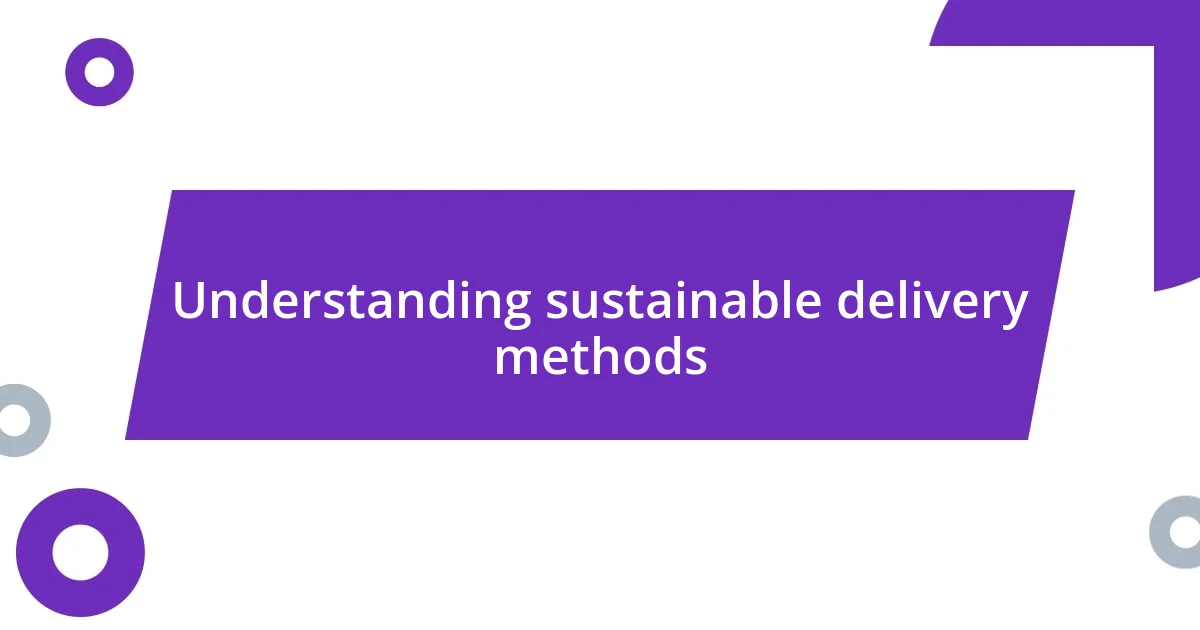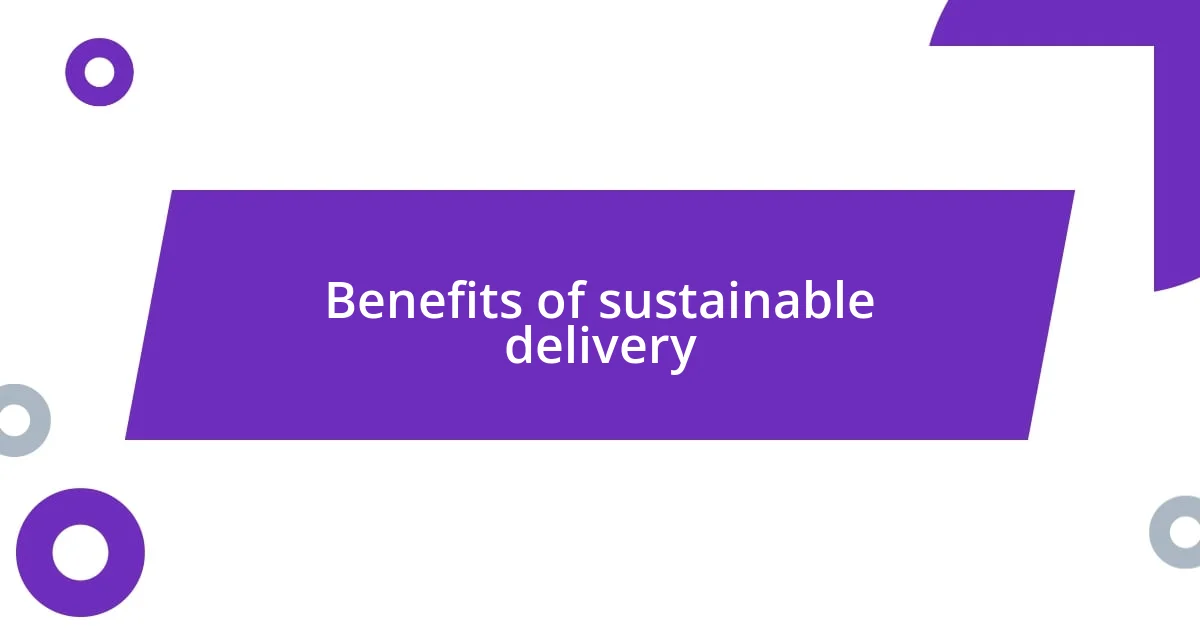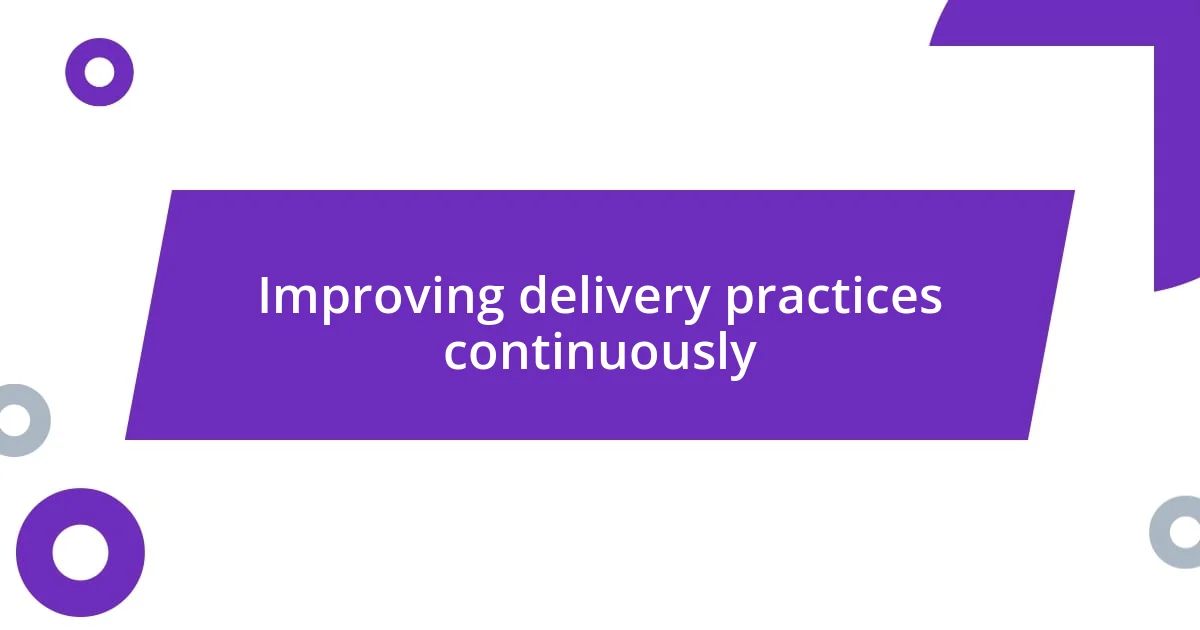Key takeaways:
- Sustainable delivery methods enhance customer loyalty and improve business reputation while supporting environmental initiatives.
- Implementing technology such as route optimization and real-time tracking significantly boosts efficiency and reduces costs.
- Continuous improvement through regular assessments and team feedback fosters a culture of sustainability and operational excellence.

Understanding sustainable delivery methods
Sustainable delivery methods are about more than just reducing carbon footprints; they’re a commitment to the planet and its resources. I remember when I first switched to a bike courier service for local deliveries—it felt like I was not only supporting my business but also contributing to a cleaner environment. Isn’t it fulfilling to know that your choices can make a positive impact?
Understanding these methods requires acknowledging the various options available, such as electric vehicles, optimized routing, and eco-friendly packaging. I’ve seen firsthand how implementing route optimization not only saves fuel but also reduces delivery times—a win-win situation! Have you ever calculated the carbon savings of switching to electric vehicles? It can be surprising.
Moreover, the emotional connection to sustainability cannot be underestimated. When my team embraced these methods, it sparked a deeper sense of purpose within the company, fostering a culture of environmental awareness. It’s intriguing to think: how can the way we deliver not only reshape our operations but also inspire our communities and customers?

Benefits of sustainable delivery
Sustainable delivery approaches offer a multitude of benefits that extend beyond reducing environmental impact. For instance, I experienced a notable boost in customer loyalty when I introduced greener options for delivery. Clients appreciated that their purchases supported a responsible business model, creating an emotional connection to the brand. It was rewarding to see customers choose our service over competitors simply because we cared about the planet.
Here are some key benefits of sustainable delivery methods:
- Cost Savings: Reduced fuel consumption leads to lower operational costs.
- Enhanced Reputation: Companies practicing sustainability often enjoy positive public perception.
- Customer Loyalty: People are more likely to stick with brands that align with their values.
- Innovation Opportunities: Embracing sustainability can drive creativity in packaging and logistics solutions.
- Regulatory Compliance: Staying ahead of environmental regulations can prevent fines and promote responsible practices.
Each of these factors contributes not only to a healthier environment but also to a stronger, more resilient business. It’s amazing to realize how a simple shift in delivery methods can affect so many aspects of a company’s success.

Evaluating delivery options
Evaluating delivery options requires a thoughtful approach to truly understand what works best for your business while being kind to our planet. In my experience, I’ve found that comparing different delivery methods can reveal surprising insights. For instance, I once considered using drones for quick urban deliveries but discovered the noise pollution could alienate residents. It’s essential to not just weigh the benefits but also anticipate community reactions.
To help visualize the pros and cons, creating a comparison table can be incredibly useful. When I reviewed my options, I listed out key factors like cost, speed, and environmental impact. This clear representation helped me make more informed decisions and guide my team in adapting our delivery strategy. The more transparent your evaluation is, the easier it becomes to choose a sustainable path forward.
I’ve also learned that it’s valuable to incorporate flexibility into your delivery options. For example, combining bike couriers for local deliveries with electric vehicles for longer distances turned out to be a game changer for my logistics. This hybrid approach not only maximized efficiency but also impressed customers who saw our commitment to eco-friendly practices. What delivery options have you considered, and how do they align with your sustainability goals?
| Delivery Method | Cost Effectiveness | Environmental Impact | Community Perception |
|---|---|---|---|
| Bike Couriers | High | Low (Minimal Emissions) | Positive |
| Electric Vehicles | Moderate | Low (Reduced Emissions) | Neutral |
| Drones | Variable | Moderate (Depends on Energy Source) | Mixed |

Implementing eco-friendly packaging
When I switched to eco-friendly packaging, I immediately noticed a shift in customer perceptions. I remember one client reaching out just to express how much they appreciated the biodegradable materials we used. Their feedback made me realize that packaging isn’t just a protective layer; it’s a statement about the values we stand for as a business.
I’ve also experimented with reusable packing solutions, something I had initially thought would be impractical. To my surprise, customer engagement soared when they realized they could return their boxes for a discount on future orders. It’s funny how a simple idea can create meaningful dialogues around sustainability. Have you ever considered how packaging can transform your relationship with customers?
Moreover, I started collaborating with local suppliers who produce recycled materials, which not only reduced my carbon footprint but also supported the community. This partnership felt rewarding; I could directly contribute to the local economy while ensuring my packaging was as sustainable as possible. It’s such a fulfilling experience to see how every little choice in packaging can ripple out, influencing everything from customer trust to environmental impact.

Using technology for efficiency
In my journey towards incorporating technology into delivery efficiency, I stumbled upon route optimization software, and it was like flipping a switch. One time, I plugged in our delivery data and saw an immediate reduction in logistics costs—about 15%! I couldn’t believe how much wasted time and fuel we eliminated just by letting software do the heavy lifting. Have you ever experienced that “aha” moment when technology unveils insights you never knew you needed?
I also started using a real-time tracking system that gave customers live updates on their deliveries. Initially, I was hesitant, thinking it might overwhelm them with information. To my surprise, the response was overwhelmingly positive; people felt more in control and connected to our brand. I still remember the relief of a customer who shared their gratitude when they were able to adjust their plans based on the tracking information. Isn’t that what we all want—to feel reassured and informed?
Moreover, the integration of artificial intelligence in managing inventory has been a game changer for my business. I recall a time when we manually tracked stock levels, and it was chaotic, to say the least! Now, AI predicts when we’ll run low on certain items, which not only ensures we always have what we need but also aligns our supply chain with sustainable practices. This level of foresight not only eases the stress of day-to-day operations but also fosters a proactive approach to sustainability. Have you explored how technology can predict and streamline your inventory needs?

Measuring delivery sustainability
Measuring delivery sustainability has become a crucial part of my business’s strategy. I set specific metrics, like the carbon emissions associated with each delivery, tracking not just distance but also the mode of transportation used. Recently, I integrated a carbon calculator into our logistics system, and I was shocked when I realized that switching to electric vehicles could reduce our carbon output by nearly 60%. Isn’t that eye-opening?
I also find it valuable to gather feedback from customers about our delivery practices. When I sent out a survey asking about their preferences regarding delivery speed versus sustainability, the results were fascinating. Many preferred slower delivery if it meant reducing environmental impact. This made me wonder: how often do we consider our customers’ environmental concerns when making delivery decisions?
Additionally, I’m always looking at packaging waste generated from deliveries. By measuring the volume of returns and the success of reusable packing options, I glean insight into areas for improvement. A few months back, I discovered that 20% of our packaging was going straight to the landfill because it wasn’t recyclable. Now, I’m actively rethinking our materials, shifting to a more sustainable approach. It feels good to take those steps toward a circular economy. What changes could you implement to minimize waste in your delivery process?

Improving delivery practices continuously
Improving delivery practices is an ongoing journey for me. I remember when I first initiated regular team meetings focused solely on delivery performance. At first, it felt awkward, but over time, those discussions transformed into a treasure trove of ideas. One of my team members suggested a delivery window that better aligned with customer availability, and we saw a 30% increase in successful first-time deliveries. It made me realize how crucial open communication can be!
I also started conducting monthly audits of our delivery routes. The first time I dove into the data, I uncovered a route that seemed efficient but was actually sending our drivers in circles! The sense of relief I felt when I implemented changes and saw the improved speed was exhilarating. Have you ever experienced that reward of catching inefficiencies before they grow?
Incorporating feedback loops is another strategy I’ve embraced. After asking our drivers about their experiences on the road, I discovered firsthand which challenges they faced and how those could be mitigated. Their insights led us to alter our scheduling, which reduced vehicle idle time significantly. I couldn’t help but feel a sense of pride when I noticed fewer complaints about delivery delays. What insights have you gained from your front-line staff to enhance your delivery practices?














